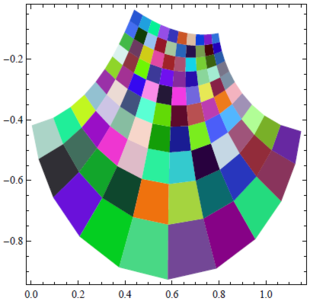14-240/Tutorial-October14: Difference between revisions
From Drorbn
Jump to navigationJump to search
(→Boris) |
(→Boris) |
||
| Line 3: | Line 3: | ||
==Boris== |
==Boris== |
||
====Elementary and (Not So Elementary) Errors in Homework==== |
|||
Location of midterm next week: HS610 |
|||
(1) Let <math> |
|||
M_1 = |
|||
\begin{pmatrix} |
|||
1 & 0 \\ |
|||
0 & 0 |
|||
\end{pmatrix}, |
|||
M_2 = |
|||
\begin{pmatrix} |
|||
0 & 0 \\ |
|||
0 & 1 \\ |
|||
\end{pmatrix}, |
|||
M_3 = |
|||
\begin{pmatrix} |
|||
0 & 1 \\ |
|||
1 & 0 \\ |
|||
\end{pmatrix} |
|||
</math>. |
|||
We want to equate <math>span(M_1, M_2, M_3)</math> to the set of all symmetric <math>2 \times 2</math> matrices. |
|||
Here is the wrong way to do it: |
|||
<math> |
|||
span(M_1, M_2, M_3) = |
|||
\begin{pmatrix} |
|||
a & b \\ |
|||
b & c \\ |
|||
\end{pmatrix} |
|||
</math>. |
|||
Firstly, <math>span(M_1, M_2, M_2)</math> is tje set of all linear combinations of <math>M_1, M_2, M_3</math>. To equate it to a single symmetric <math>2 \times 2</math> matrix makes no sense. Secondly, the elements <math>a, b, c, d</math> are undefined. What are they suppose to represent? Rational numbers? Real numbers? Members of the field of two elements? |
|||
Here is a better way to do it: |
|||
<math> |
|||
span(M_1, M_2, M_3) = \{ |
|||
\begin{pmatrix} |
|||
a & b \\ |
|||
b & c \\ |
|||
\end{pmatrix} |
|||
:a, b, c \in F \} |
|||
</math> where <math>F</math> is an arbitrary field. |
|||
==Nikita== |
==Nikita== |
||
Revision as of 16:56, 14 October 2014
| |||||||||||||||||||||||||||||||||||||||||||||||||||||||||
Boris
Elementary and (Not So Elementary) Errors in Homework
(1) Let . We want to equate to the set of all symmetric matrices.
Here is the wrong way to do it:
.
Firstly, is tje set of all linear combinations of . To equate it to a single symmetric matrix makes no sense. Secondly, the elements are undefined. What are they suppose to represent? Rational numbers? Real numbers? Members of the field of two elements?
Here is a better way to do it:
where is an arbitrary field.










